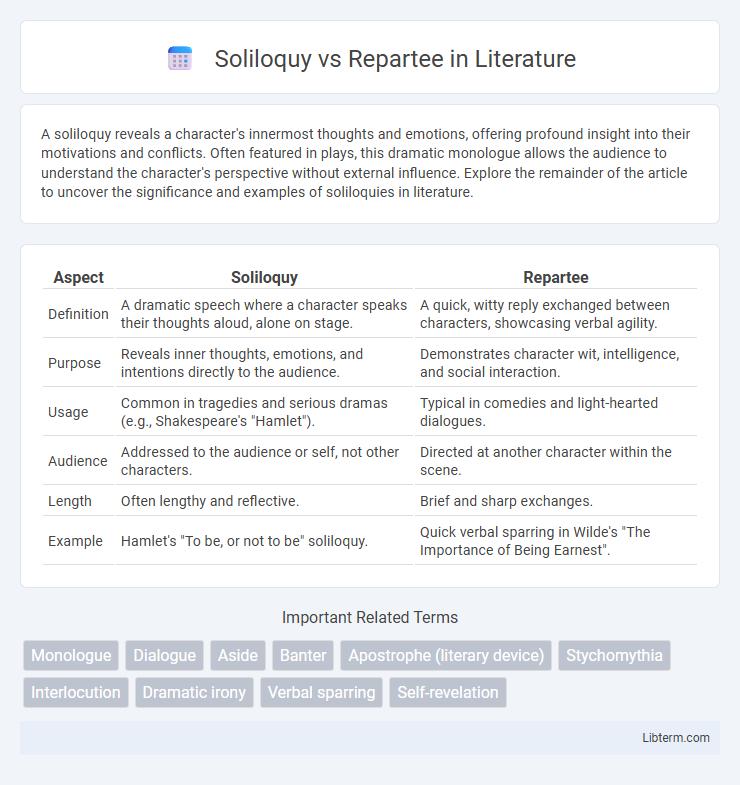A soliloquy reveals a character's innermost thoughts and emotions, offering profound insight into their motivations and conflicts. Often featured in plays, this dramatic monologue allows the audience to understand the character's perspective without external influence. Explore the remainder of the article to uncover the significance and examples of soliloquies in literature.
Table of Comparison
| Aspect | Soliloquy | Repartee |
|---|---|---|
| Definition | A dramatic speech where a character speaks their thoughts aloud, alone on stage. | A quick, witty reply exchanged between characters, showcasing verbal agility. |
| Purpose | Reveals inner thoughts, emotions, and intentions directly to the audience. | Demonstrates character wit, intelligence, and social interaction. |
| Usage | Common in tragedies and serious dramas (e.g., Shakespeare's "Hamlet"). | Typical in comedies and light-hearted dialogues. |
| Audience | Addressed to the audience or self, not other characters. | Directed at another character within the scene. |
| Length | Often lengthy and reflective. | Brief and sharp exchanges. |
| Example | Hamlet's "To be, or not to be" soliloquy. | Quick verbal sparring in Wilde's "The Importance of Being Earnest". |
Introduction to Soliloquy and Repartee
Soliloquy is a dramatic device where a character speaks their thoughts aloud, often alone on stage, providing deep insight into their inner emotions and motivations. Repartee is a fast, witty exchange of remarks between characters, showcasing verbal agility and sharp intellect in dialogue. Both techniques enrich storytelling by revealing characters' minds and relationships in distinct, engaging ways.
Defining Soliloquy: An Introspective Monologue
Soliloquy is a dramatic device where a character speaks their thoughts aloud, revealing inner emotions and conflicts to the audience without addressing other characters. This introspective monologue offers insight into the character's motivations, fears, and plans, distinguishing it from dialogue or external interaction. In contrast, repartee involves quick, witty exchanges between characters, emphasizing social interaction rather than self-reflection.
Understanding Repartee: The Art of Quick Dialogue
Repartee is the art of quick, witty dialogue characterized by sharp and immediate responses that demonstrate verbal agility and intellectual sharpness. Unlike soliloquy, which involves a character speaking their thoughts aloud alone, repartee occurs in dynamic exchanges between two or more participants, emphasizing spontaneity and cleverness. Mastery of repartee enhances communication by fostering engaging and memorable conversations through rapid-fire wordplay and humor.
Historical Origins of Soliloquy and Repartee
Soliloquy originated in ancient Greek and Roman drama, serving as a theatrical device to reveal a character's inner thoughts directly to the audience, with notable development in Elizabethan plays like those of Shakespeare. Repartee traces its roots to French Renaissance salons, where quick-witted exchanges became a social art form reflecting intelligence and charm in conversational settings. Both forms evolved as distinct communication styles: soliloquies emphasize introspection in theater, while repartee highlights spontaneous verbal agility in social interaction.
Key Differences Between Soliloquy and Repartee
Soliloquy involves a character speaking their thoughts aloud when alone, revealing internal emotions and motivations, while repartee is a quick, witty exchange of dialogue between two or more characters. Soliloquy is a dramatic device used in plays for introspection, whereas repartee serves as a conversational tool for humor and sharpness in dialogue. The primary difference lies in soliloquy's solitary monologue versus repartee's interactive, spontaneous verbal sparring.
Famous Examples of Soliloquy in Literature
Famous examples of soliloquy in literature include Hamlet's "To be, or not to be" from Shakespeare's *Hamlet*, which explores themes of existence and despair, and Macbeth's "Tomorrow, and tomorrow, and tomorrow" reflecting on the futility of life. These soliloquies reveal characters' inner thoughts and emotions, providing insight into their psychological states. In contrast, repartee involves quick, witty dialogue exchange between characters, emphasizing social interaction rather than introspection.
Notable Instances of Repartee in Drama
Repartee in drama showcases quick, witty exchanges that reveal character intelligence and tension, exemplified in Oscar Wilde's *The Importance of Being Earnest*, where characters spar with sharp dialogue. Shakespeare's *Much Ado About Nothing* features Beatrice and Benedick's clever verbal duels, highlighting their lively repartee. These instances emphasize the use of repartee as a tool for character development and thematic depth in theatrical works.
Dramatic Functions: Impact on Character Development
Soliloquy reveals a character's innermost thoughts and emotions, providing deep psychological insight and driving their personal transformation. Repartee showcases quick, witty exchanges that highlight social intelligence and reveal character dynamics through verbal sparring. Both devices enrich character development by exposing internal conflicts and interpersonal relationships crucial to the narrative.
Effect on Audience Engagement
Soliloquy offers deep insight into a character's inner thoughts, creating a powerful emotional connection that draws the audience into the psychological landscape of the narrative. Repartee, characterized by quick, witty exchanges, energizes the dialogue and fosters a lively interaction that keeps the audience intellectually engaged and entertained. Both techniques enhance audience engagement differently: soliloquies evoke empathy and introspection, while repartee stimulates mental agility and social dynamics.
Soliloquy vs Repartee: Which Suits Your Story?
Soliloquy and repartee serve distinct narrative functions, with soliloquy revealing a character's inner thoughts and emotions through extended monologues, ideal for deep psychological exploration. Repartee involves quick, witty exchanges between characters, enhancing dialogue-driven scenes and emphasizing character relationships or humor. Choosing between soliloquy and repartee depends on whether your story prioritizes introspective depth or dynamic, engaging interaction.
Soliloquy Infographic

 libterm.com
libterm.com